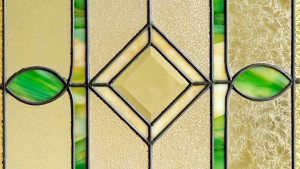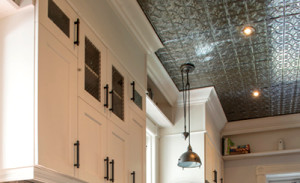Unique architectural features can greatly enhance the value of your building. The range of materials found in today’s architecture is vast and changing constantly as new materials and technologies are developed. Vintage or custom features such as wall surfaces, tile and carvings are just a few of the items you’ll want to preserve.
One material might be used several different ways in the same building. For example, ceramic tile could be found as both bathroom flooring and on the exterior façade. Glass may be used for windows, ceilings, walls or flooring. Architectural conservators are familiar with both historic and modern building materials because both may be incorporated into a structure and require conservation or antique restoration.

Leaded glass is an example of a custom feature worth preserving.
ENVIRONMENT | ART RESTORATION
Materials react in some way to their environment. Because structures are built to stay in one place, exposure to water, sunlight, heat and cold weather can deteriorate building materials.
Water is particularly damaging. Your building exterior needs inspection regularly for signs of water infiltration. Roof damage or missing shingles are common locations. Sometimes poor design is the culprit.Skillful retrofitting of existing details can eliminate the water infiltration problem and preserve the historic appearance or delay the need for antique restoration.

Regular inspections can help identify problems before they damage crown molding or tin ceilings.
Enhance your property’s value by preserving custom features – The Cincinnati Insurance Companies blog
Buildings are generally designed to protect interior spaces from the exterior environment, so that environment is more easily controlled. Unfortunately, temperatures and humidity levels that are comfortable for people may not be best for building materials. An architectural conservator and antique restoration specialist knows how to maintain a balance between the two. Sometimes even simple steps, such as providing ventilation in areas where moisture accumulates or installing vapor barriers to prevent moisture migration, can make significant differences.
First, however, one must accurately identify problems.
INSPECTION AND MAINTENANCE
A regular program of inspection and maintenance is the most critical step in preserving a structure. Check all the materials that might be used in architectural features, for example, wood, stone, metal, glass, plaster, ceramic, brick, terra cotta, concrete, paint, plastic, asphalt and rubber. Tools to have on hand for conducting an inspection might include a ladder, binoculars and powerful flashlights.
Enhance your property’s value by preserving custom features – The Cincinnati Insurance Companies blog
WHAT NEEDS INSPECTION
- Places where water could infiltrate: roofs, gutters, downspouts, subsurface drainage systems
- Functional building elements: doors, windows, fireplace flues
- Exterior materials: bricks, stone, mortars, wood sheathing
- Interior materials: wood framing, flooring, wood trim, plaster
- Plumbing, heating and cooling systems: a systems engineer should inspect these
WHAT TO LOOK FOR
- Water damage: stains, soft wood (rot), peeling paint, salt crystals
- Signs of infestation: droppings, dead insects, holes in wood (place glue traps to check for insects)
- Anything unusual or different from your last inspection
You may find it cost effective to hire a conservator or art restoration specialist to conduct the inspection because they are trained to catch problems early and can help prepare a prioritized preservation plan. Certainly they are the best-qualified people to carry out the inspection of large, complex, abandoned or neglected structures.
Contact RC4 Insurance Agency LLC for advice on coverage to protect fine art and other items of value.
Article by Doug Eisele president and owner of Eisele Gallery of Fine Art and Old World Restorations Inc. in Cincinnati.

